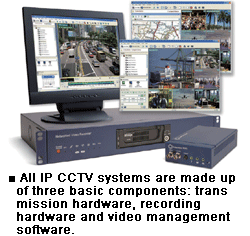It is increasingly important that end users understand the difference between single-vendor and multi-vendor IP video systems. Oliver Vellacott, President and CEO of IndigoVision , discusses the advantages and disadvantages of each approach and the impact of choosing a system.
It is increasingly important that end users understand the difference between single-vendor and multi-vendor IP video systems. Oliver Vellacott, President and CEO of IndigoVision , discusses the advantages and disadvantages of each approach and the impact of choosing a system.
Many people in the industry believe that open or multi-vendor IP video systems achieve interoperability through use of open industry standards. This is a myth. There are a number of aspects to IP video that are genuinely standard-based. One of these is video compression. MPEG-2, MPEG-4, H.263, H.264 and JPEG-2000 are all ratified standards and commonly used in the IP CCTV industry. These formats cover only digital compression and decompression of analog video, not live streaming of digital video.
IP video systems require digital video to be transmitted in real time around the  network. For this, a transmission and control protocol is required. These protocols are transmitted using the Ethernet IP network standard, which allows IP video to coexist with other network traffic such as general computer information. There are many transmitters on the market that use standard video compression yet depend on proprietary streaming protocols. It is the transmission and control protocol that is the most nonstandard element in the system. However, it is this element that allows many of the advanced features found in IP video systems to be realized.
network. For this, a transmission and control protocol is required. These protocols are transmitted using the Ethernet IP network standard, which allows IP video to coexist with other network traffic such as general computer information. There are many transmitters on the market that use standard video compression yet depend on proprietary streaming protocols. It is the transmission and control protocol that is the most nonstandard element in the system. However, it is this element that allows many of the advanced features found in IP video systems to be realized.
The protocol contains a number of basic commands that, for example, allow video recording to be started and stopped, alarms to be sent or cameras to be panned. All manufacturers use their own protocols and, without them, the system cannot work. Add video analytics to an IP system and the complexity of the protocol is dramatically increased. There is a similar situation with analog video systems where video transmission is standard but pan-tilt-zoom (PTZ) and matrix controls are proprietary.
The reality of open systems is that video management software has to interface to different vendor equipment using separate proprietary protocolsfar from a standard-based solution.
Single Vendor or Multiple Vendors?
All IP CCTV systems are made up of the following three basic components: transmission hardware, recording hardware and video management software. Some manufacturers have taken the complete-solution approach and are single vendors, with all software and hardware designed, tested and sold as a single integrated system. Other manufacturers have chosen the open approach and are multi-vendor players, such that a single video management software application can communicate with equipment from various manufacturers transmitters, IP cameras and so on. This has the following advantages:
Ability to source from multiple manufacturers
Lower pricing on hardware components
Stand-alone software providers often sell across a wider market, so the end user can benefit from this investment and resulting features
The user is not locked into any one hardware manufacturer agenda whether a development road map or application bias
Ability to upgrade installed IP video systems with new third-party hardware
Ability to choose the most suitable manufacturer for the specific application, such as a particular type of IP camera
While the multi-vendor approach seems at first to be the most sensible solution, it has drawbacks as well. Multi-vendor approaches usually mean buying video management software from an independent software vendor that can communicate with equipment from a number of transmitter and IP camera manufacturers. The hardware is open, but the end user is still tied to a single software developer. So, instead of single-source solutions, they have single-source video management software.
This is fine, but the independent software vendor has far less control over the hardware from the multiple manufacturers that they support. Therefore, in the absence of real standards, they are less able to deploy a system with optimum performance compared with a single vendor that controls the entire solution from end to end.
Some believe that multi-vendor software applications allow users to seamlessly and inexpensively source transmission hardware from any manufacturer. However, there are many limitations in multi-vendor systems that make it difficult to freely mix and match between different manufacturers. The system is only as good as the worst performing componentthe lowest common denominator and this can lead to a reduction in overall functionality. In reality, many IP video systems based on multi-vendor solutions actually use hardware from only one manufacturer to reduce these limitations, effectively making the system dual vendor.
Many IP CCTV systems require hardware-to-hardware communication, such as streaming from the transmitter to the hardware decoderan important element in virtual matrices that provide IP video systems with flexibility and scalability. No amount of software will allow these two components to be integrated so a key component of an IP virtual matrixa link from anywhere to anywhereis negated.
In terms of development, the most expensive component in an IP CCTV system is video management software, although true costs are often hidden. By sourcing from an independent software vendor, users are simply tying themselves down to the most expensive component in the system. Also, need to incorporate control protocols from equipment from many vendors into one software application further increases development cost. This is why multi-vendor support is often priced at a premium and this means that customers are being charged for supporting hardware that they do not use.
Video management software is required to interface to several different technologies, and this increased complexity can affect system reliability and highlight support problems. Multi-vendor systems depend on strong strategic alliances from many different companies to maintain integrated support. If something were to go wrong, who does the end user blame? Who takes responsibility for what revision of firmware should be used in an IP camera when a new version of the video management software is released? With a single-vendor complete solution, responsibility for performance lies clearly in one place and the end user need only point one finger.
Single-Vendor Systems
With a single-vendor solution, all IP video components are sourced from a single manufacturer, reducing end user choice. However, in reality, many components can still be selected from other vendors. IP video systems often use a combination of analog cameras connected to transmitter modules, as opposed to dedicated IP camerasas is the case with set-top boxes and TVs for home entertainment. In this case, the end user can choose any manufacturer camera based on cost, specification or brand.
Similarly, many manufacturers enable their NVR software to run on any IT configuration, allowing the user to choose anything from a low-cost PC to a multi-RAID server setup. IP video systems also provide multiple interfaces to equipment from other manufacturers such as display monitors, keyboards and joysticks, further expanding choice.
Another misconcept ion is that integrating with third-party equipment is more easily achieved with multi-vendor IP video systems, as single-vendor systems are perceived to be closed. This is far from the truth. In many cases integrating IP video with other types of systems, such as intruder alarm and access control, is more easily achieved with single vendor solutions. This is because control of different components and software in the system is in the hands of one company, ensuring integration is seamless throughout.
The split within the IP video market into multi-vendor and single-vendor systems  mimics, to some extent, what happens in the IT networking world. Small organizations are quite likely to use multiple manufacturers of network equipment, changing their selection from day to day based mainly on price. Medium and large organizations, on the other hand, tend to run all Cisco or all Hewlett-Packard because that gives them a much higher overall performance and lower total cost of ownership. The same is true in IP video, where medium to larger users are tending to choose the single-vendor route for the very same reasons.
mimics, to some extent, what happens in the IT networking world. Small organizations are quite likely to use multiple manufacturers of network equipment, changing their selection from day to day based mainly on price. Medium and large organizations, on the other hand, tend to run all Cisco or all Hewlett-Packard because that gives them a much higher overall performance and lower total cost of ownership. The same is true in IP video, where medium to larger users are tending to choose the single-vendor route for the very same reasons.
Integrating Video Analytics
IP-based video management systems provide the ideal platform for powerful analytics to be completely integrated into the system, making them a core and integral part of operation. Leading IP video solutions support analytics that can be performed in two fundamental modes: live (to detect events as they occur) and post processing (to test various scenarios on recorded footage).
The optimum place to locate live analytics is obviously at the camera, as it is the only truly scalable solution and also does not use up network bandwidth.
Central real-time processing will eventually run out of steam, whereas every camera can have dedicated processing. For example, a camera with built-in analytics can monitor scene activity and transmit only on specified events (persons moving the wrong way through airport security).
The optimum place to locate post-processing analytics is obviously on a central server within the video management software, so that recorded video can be searched many times, with different parameters. Both types of systems can perform these post-event analytic functions perfectly well in the video management software. However, implementing real-time analytics at the camera in multi-vendor systems becomes very difficult because of the extra complexity required within numerous control protocols that interface to video management software.
At first glance, therefore, the open or multi-vendor solution appears to be the best approach when selecting a CCTV system, offering the end user more choice and the opportunity of not being tied to one manufacturer. However, after closer inspection, a complete solution or single-vendor approach also has many benefitsit is potentially more robust and feature-rich as well as offering simpler support and, in many cases, being less expensive.
The debate between single and multi-vendor solutions will, of course, continue, but it is interesting to note that most of the biggest names in the IP video industry supply single-vendor systems that are capable of higher performance. The biggest proponents of multi-vendor systems are invariably independent vendors of video management software.